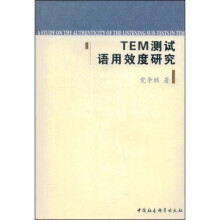TEM测试语用效度研究

CHAPTER ONE INTRODUCTION
1.1 TEM4 and TEM8 in China
1.1.1 An overview of TEM4 and TEM8
1.1.2 An overview of current listening comprehension parts of TEM4 and TEM8
1.1.3 TEM4 and TEM8 listening test validation study
1.2 Description of the thesis study
1.2.1 Purpose and scope of the study
1.2.2 The research questions
1.2.3 Study methods
1.2.4 Study results
1.2.5 Structure of the dissertation
CHAPTER TWO LITERATURE REVIEW
2.1 Language competence
2.1.1 Classical UCH versus MCH
2.1.2 Varying definitions of language proficiency
2.1.3 The influence of pedagogic approaches on the interpretation of language competence
2.1.4 Some recent frameworks of communicative competence
2.2 Listening competence
2.2.1 Major listening situations and their classifications
2.2.2 Listening comprehension as hypothesized processes
2.2.3 Buck's framework of listening ability
2.3 Two supplementary points about listening comprehension
2.3.1 The passive and active natures of listening comprehension
2.4 Listening comprehension testing: pre-World War II period
2.4.1 The three major approaches to language testing
2.4.2 Earlier listening comprehension testing in the U.S
2.4.3 Earlier listening comprehension testing in the U. K
2.5 Listening comprehension testing: post-World War II period
2.5.1 overseas studies
2.5.2 Studies in China
2.6 Progress in listening comprehension testing: after the
1980s
2.6.1 Progress made in people's knowledge about listening competence
2.6.2 A framework for listening comprehension
2.6.3 Progress made in theories concerning the effect of test method
2.7 Formats of listening comprehension sub-tests in some famous English proficiency tests
2.8 Conclusion
CHAPTER THREE A TENTATIVE ANALYSIS AND COMMENT 0N TEM4 AND TEM8 LISTENING COMPREHENSION TEST PAPERS IN USE
3.1 Test authenticity
3.2 TEM4 and TEM8 item type analysis
3.3 TEM4 and TEM8 listening test content analysis
3.4 TEM4 and TEM8 test task analysis
3.5 Comments on the test papers in use
3.5.1 The positive side of the papers and their beneficial backwash on pedagogy
3.5.2 The imperfections of the papers and their detrimental backwash Off pedagogy
CHAPTER FOUR LISTENINGNEEDS ANALYSIS
4.1 Needs analysis
4.2 Important listening domains
4.3 Real-life listening situations and tasks
4.3.1 Varieties of English language
4.3.2 The matter of accents
4.4 Correspondence between test tasks and real-life listening activities
4.4.1 Seeking correspondence between the test taker’S psychological state and that of the non-test taker’s
4.4.2 Seeking correspondence between the test language and the real.1ife language
4.4.3 Seeking correspondence between test tasks and real-life listening activities
4.5 Conclusion
CHAPTER FIVE REVISED TEST SPECIFICATIONS FOR TEM LISTENING SUB-TESTS
5.1 Test Specifications
5.2 Original test specifications for TEM4 listening sub-test
5.3 ReviSed test specifications for TEM4 listening sub-test
5.4 Original test specifications for TEM8 listening sub-test
5.7 Revised test specifications for了EM8 listening sub-test
5 6 Conclusion
CHAPTER SIX THE EXPERIMENTAL TEST AND THE RESULTS ANALYSIS
6.1 Two assumptions to be tested
6.2 Construction of the experimental test
6.3 Administration of the experimental test
6.4 Test results analysis
6.4.1 The T test results
6.4.2 Facility value and discrimination power analysis
6.5 Questionnaire survey
CHAPTER SEVEN CONCLUSIONS AND RECOMMENDATIONS
BIBOLIOGRAPHY
1.1 TEM4 and TEM8 in China
1.1.1 An overview of TEM4 and TEM8
1.1.2 An overview of current listening comprehension parts of TEM4 and TEM8
1.1.3 TEM4 and TEM8 listening test validation study
1.2 Description of the thesis study
1.2.1 Purpose and scope of the study
1.2.2 The research questions
1.2.3 Study methods
1.2.4 Study results
1.2.5 Structure of the dissertation
CHAPTER TWO LITERATURE REVIEW
2.1 Language competence
2.1.1 Classical UCH versus MCH
2.1.2 Varying definitions of language proficiency
2.1.3 The influence of pedagogic approaches on the interpretation of language competence
2.1.4 Some recent frameworks of communicative competence
2.2 Listening competence
2.2.1 Major listening situations and their classifications
2.2.2 Listening comprehension as hypothesized processes
2.2.3 Buck's framework of listening ability
2.3 Two supplementary points about listening comprehension
2.3.1 The passive and active natures of listening comprehension
2.4 Listening comprehension testing: pre-World War II period
2.4.1 The three major approaches to language testing
2.4.2 Earlier listening comprehension testing in the U.S
2.4.3 Earlier listening comprehension testing in the U. K
2.5 Listening comprehension testing: post-World War II period
2.5.1 overseas studies
2.5.2 Studies in China
2.6 Progress in listening comprehension testing: after the
1980s
2.6.1 Progress made in people's knowledge about listening competence
2.6.2 A framework for listening comprehension
2.6.3 Progress made in theories concerning the effect of test method
2.7 Formats of listening comprehension sub-tests in some famous English proficiency tests
2.8 Conclusion
CHAPTER THREE A TENTATIVE ANALYSIS AND COMMENT 0N TEM4 AND TEM8 LISTENING COMPREHENSION TEST PAPERS IN USE
3.1 Test authenticity
3.2 TEM4 and TEM8 item type analysis
3.3 TEM4 and TEM8 listening test content analysis
3.4 TEM4 and TEM8 test task analysis
3.5 Comments on the test papers in use
3.5.1 The positive side of the papers and their beneficial backwash on pedagogy
3.5.2 The imperfections of the papers and their detrimental backwash Off pedagogy
CHAPTER FOUR LISTENINGNEEDS ANALYSIS
4.1 Needs analysis
4.2 Important listening domains
4.3 Real-life listening situations and tasks
4.3.1 Varieties of English language
4.3.2 The matter of accents
4.4 Correspondence between test tasks and real-life listening activities
4.4.1 Seeking correspondence between the test taker’S psychological state and that of the non-test taker’s
4.4.2 Seeking correspondence between the test language and the real.1ife language
4.4.3 Seeking correspondence between test tasks and real-life listening activities
4.5 Conclusion
CHAPTER FIVE REVISED TEST SPECIFICATIONS FOR TEM LISTENING SUB-TESTS
5.1 Test Specifications
5.2 Original test specifications for TEM4 listening sub-test
5.3 ReviSed test specifications for TEM4 listening sub-test
5.4 Original test specifications for TEM8 listening sub-test
5.7 Revised test specifications for了EM8 listening sub-test
5 6 Conclusion
CHAPTER SIX THE EXPERIMENTAL TEST AND THE RESULTS ANALYSIS
6.1 Two assumptions to be tested
6.2 Construction of the experimental test
6.3 Administration of the experimental test
6.4 Test results analysis
6.4.1 The T test results
6.4.2 Facility value and discrimination power analysis
6.5 Questionnaire survey
CHAPTER SEVEN CONCLUSIONS AND RECOMMENDATIONS
BIBOLIOGRAPHY
党争胜,男,1967年生,陕西富平人。西安外国语大学副教授,西安外国语大学欧美语言文学研究中心成员,上海外国语大学博士,主要从事语言测试与翻译理论研究。近年来在《外语教学与研究》、《外语学刊》、《外语教学》、《外语电化教学》等于刊物发表论文二十多篇,在上海外语教育出版社、外语教学与研究出版社和西安交通大学出版社出版《语言测试》、《文学翻译鉴赏导论》、《论语今译》等著作四部。
《TEM测试语用效度研究》从语用效度的视角,对我国高校英语专业考试(TEM)听力部分的考试大纲、试题质量、考试和教学的关系等问题进行了实证性研究。通过对国内外听力测试研究的总结评述、对教学大纲和考试大纲的对比分析、以及对英语专业大学生听力需求的调查研究,对我国高校现用的TEM考试听力测试的改革和完善提出了解决方案,设计了有利于提高指导功能的新大纲和测试语用效度的新题型。
比价列表
公众号、微信群
 缺书网
缺书网微信公众号
 扫码进群
扫码进群实时获取购书优惠





